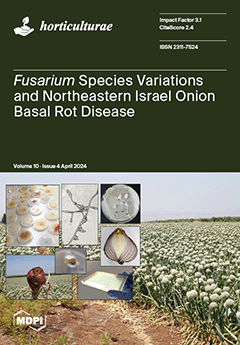Water is one of the most important elements affecting the growth of ornamental plants. To investigate the effects of drought stress on the growth, ornamental values, and physiological properties of
Begonia semperflorens, watering treatments with 250 mL (control check, CK), 200 mL (extremely light drought, ELD), 150 mL (light drought, LD), 100 mL (moderate drought, MD), 50 mL (severe drought, SD), and 25 mL (extremely severe drought, ESD) on the
B. semperflorens variety “Chao Ao” were performed in this study. As a result, compared to the control (CK), the number of flowers, leaves, and branches, leaf size, plant height, crown diameter, as well as water content, transpiration rate, net photosynthetic rate, stomatal conductance, intercellular CO
2 concentration, and chlorophyll content in leaves decreased, followed by an increased amount of drought stress. The contents of the osmotic adjustment substances, such as soluble sugar, soluble protein, proline, and betaine, were increased under drought stress. Indicators related to antioxidant activities, such as SOD activity, increased and then decreased. The POD activity, CAT activity, MDA content, and plasma membrane permeability of
B. semperflorens were higher under increased drought stress than in the control condition. The APX activity decreased and then increased under drought stress. In conclusion,
B. semperflorens responds to drought stress by increasing osmotic adjustment substances and antioxidant activities and reducing the water loss, growth potential, and photosynthetic rate. The correlation analysis showed that, except for APX, the drought resistance coefficients of 23 other indexes were correlated in different degrees. Therefore, this study suggests that
B. semperflorens has a strong drought resistance ability, retaining high ornamental values in conditions of moderate drought stress, and can still survive under extremely high drought stress.
Full article





